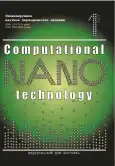Computer Simulation of Li and Be Wetting Layers on the Si (100) Surface
- Authors: Zavodinsky V.G.1, Gorkusha O.A.1, Plusnin N.I.2
-
Affiliations:
- Khabarovsk branch at Institute of Applied Mathematics of the Far Eastern branch of the Russian Academy of Sciences
- Military Academy of Communications named after Marshal of the Soviet Union S.M. Budyonny
- Issue: Vol 11, No 1 (2024)
- Pages: 121-126
- Section: COMPUTER MODELING AND DESIGN AUTOMATION SYSTEMS
- URL: https://journal-vniispk.ru/2313-223X/article/view/256203
- DOI: https://doi.org/10.33693/2313-223X-2024-11-1-121-126
- ID: 256203
Cite item
Abstract
Within the framework of the of density functionality theory and the pseudopotential method, the atomic and electronic structure of the two-dimensional Li–Si and Be–Si systems forming on the Si (100) surface is calculated, with a metal thickness of one to three monolayers (ML). At the first ML, the formation of ordered silicide wetting layer of Li (with atoms embedded inside the top layer Si) and Be (with atoms embedded between the top two Si layers) was detected. At 2 ML, the systems are modified: Li atoms occupy positions between the top two Si layers, and Be atoms rise at positions above the top Si layer. After that, with a coating thickness of 3 ML, in the case of Li, a continuous disordered wetting layer is formed, and in the case of Be, a wetting layer in the form of disordered chains along the length. At 1 ML, an energy gap appears in the electronic structure of the studied systems in the density of electronic states near the Fermi level, the width of which is 1.02 eV and 0.36 eV, respectively, for Li-Si and Be-Si systems. Then the gap disappears, first for the lithium system (at 2 ML), and then, for the beryllium system (at 3 ML).
Full Text
##article.viewOnOriginalSite##About the authors
Victor G. Zavodinsky
Khabarovsk branch at Institute of Applied Mathematics of the Far Eastern branch of the Russian Academy of Sciences
Author for correspondence.
Email: vzavod@mail.ru
ORCID iD: 0000-0003-0958-6282
Dr. Sci. (Phys.-Math.), Professor, leader-researcher
Russian Federation, KhabarovskOlga A. Gorkusha
Khabarovsk branch at Institute of Applied Mathematics of the Far Eastern branch of the Russian Academy of Sciences
Email: o_garok@rambler.ru
Cand. Sci. (Phys.-Math.), senior researcher
Russian Federation, KhabarovskNicolay I. Plusnin
Military Academy of Communications named after Marshal of the Soviet Union S.M. Budyonny
Email: contact5@yandex.ru
ORCID iD: 0000-0001-9691-9721
Dr. Sci. (Phys.-Math.), senior researcher
Russian Federation, St. PetersburgReferences
- Ko Young-Jo, Chang K.J., Yi Jae-Yel. Atomic and electronic structure of Li-adsorbed on the Si (100) surfaces. Physical Review. 1997. No. 56 (15). Pp. 9575–9582. doi: 10.1103/PhysRevB.56.9575.
- Rysbaev A.S., Normurodov A.T., Khujaniyozov J., Normurodov D. On the formation of silicide films of metals (Li, Cs, Rb, and Ba) during ion implantation in Si and subsequent thermal annealing. Journal of Surface Investigation: X-ray, Synchrotron and Neutron Techniques. 2021. No. 15. Pp. 607–610. doi: 10.1134/S10274510210303.
- Hite D., Tang S., Sprunger P. Reactive epitaxy of beryllium on Si (111)-(7 × 7). Chemical Physics Letters. 2003. No. 367. Pp. 129–137. doi: 10.1016/S0009-2614(02)01637-8.
- Clark S.J., Al-Allak Y.M., Brand S., Abram R.A. Structure and electronic properties of FeS2. Phys. Rev. 1998. No. 58. Pp. 10389–10393. doi: 10.1103/PhysRevB.58.10389.
- Kohn W., Sham J.L. Self-consistent equations including exchange and correlation effects. Physical Review. 1965. No. 40. Pp. A1133–A1138. doi: 10.1103/PhysRev.140.A1133.
- Hohenberg H., Kohn W. Inhomogeneous electron gas. Physical Review. 1964. No. 136. Pp. B864–B871. doi: 10.1103/PhysRev.136.B864.
- Fuchs M., Scheffler M. Ab initio pseudopotentials for electronic structure calculations of poly-atomic systems using density-functional theory. Computational Physics Communications. 1999. No. 119. Pp. 67–98. doi: 10.1016/S0010-4655(98)00201-X.
- Beckstedte M., Kley A., Neugebauer J., Scheffler M. Density functional theory calculation for poly-atomic systems: Electronic structure, static and elastic properties and ab initio molecular dynamics. Computational Physics Communications. 1997. No. 107. Pp. 187–205. doi: 10.1016/S0010-4655(97)00117-3.
- Ceperly D.M., Alder B.J. Ground state of the electron gas by a stochastic method. Phys. Rev. Lett. 1980. No. 45. Pp. 566–569. doi: 10.1103/PhysRevLett.45.566.
- Perdew J.P., Zunger A.S. Self-interaction correction to density functional approximation for many-electron systems. Physical Review. 1981. No. 23. Pp. 5048–5079. doi: 10.1103/PhysRevB.23.5048.
- Harris F.E., Monkhorst H.J. Complete calculations of the electronic energies of solids. Phys. Rev. Lett. 1969. No. 23 (18). Pp. 1026–1030. doi: 10.1103/PhysRevLett.23.1026.
- Fritsch J., Pavone P. Ab initio calculation of the structure, electronic states, and the phonon dispersion of the Si (100) surface. Surface Science. 1995. No. 344. Pp. 159–173. doi: 10.1016/0039-6028(95)00802-0.
- Dabrowski J., Scheffler M. Self-consistent study of the electronic and structural properties of the clean Si (001)(2 × 1) surface. Appl. Surf. Sci. 1992. No. 56-58. Pp. 15–19. doi: 10.1016/0169-4332(92)90208-F.0.407.
- Gavioli L., Betti M.G., Cricenti A., Mariani C. Surface electronic structure at Si (100)-(2 × 1). Journal of Electron Spectroscopy and Related Phenomena. 1995. No. 76. Pp. 541–545. doi: 10.1016/03682048(95)02466-2.
- Hata K., Shibata Y., Shigekawa H. Fine electronic structure of the buckled dimers of Si (100) elucidated by atomically resolved scanning tunneling spectroscopy and bias-dependent imaging. Physical Review. 2001. No. 64. Pp. 235310–235315. doi: 10.1103/PhysRevB.64.235310
Supplementary files














